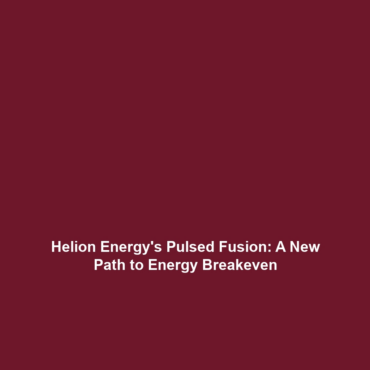Public Perception and Acceptance in Fusion Energy
Understanding Public Perception and Acceptance is critical for the advancement of Fusion Energy. This emerging energy source, which promises clean and virtually limitless power, faces various societal attitudes and acceptance challenges. As we transition towards sustainable energy solutions, exploring how the public perceives fusion technology becomes paramount in ensuring its successful implementation and widespread acceptance. This article delves into the significance of public perception and acceptance within the fusion energy landscape, highlighting its role in shaping future energy policies and innovations.
Key Concepts
The realm of Public Perception and Acceptance encompasses several major concepts that are particularly relevant in the context of Fusion Energy. Below are the core principles that define this area:
- Awareness: Public knowledge about fusion technology affects acceptance rates. Increased awareness often leads to greater support.
- Trust: Trust in scientific institutions and energy companies plays a crucial role in how people perceive energy technologies.
- Risk and Benefit Analysis: Individuals assess the potential risks versus the benefits of fusion energy compared to traditional energy sources.
- Media Influence: The portrayal of fusion energy in the media can significantly sway public opinion and acceptance.
Applications and Real-World Uses
Public Perception and Acceptance of Fusion Energy inform various real-world applications aimed at improving energy systems and policy frameworks. Notable examples include:
- Community Engagement Programs: Initiatives designed to educate the public about fusion technology increase acceptance through open dialogue and transparency.
- Public Surveys and Research Studies: Collecting data on public sentiment contributes to understanding barriers and facilitators to acceptance.
- Policy Development: Decision-makers utilize public perception insights to shape regulations and promote fusion research funding.
Current Challenges
Despite its potential, there are several challenges associated with Public Perception and Acceptance within the context of Fusion Energy. These challenges include:
- Limited Public Knowledge: A significant gap in understanding fusion technology can lead to misconceptions and fear.
- Negative Media Coverage: If fusion energy is framed negatively, it can hinder public acceptance.
- Historical Context: Previous failures in nuclear technology can cause skepticism towards fusion energy.
- Competing Energy Solutions: The rapid development of other renewable energy sources can overshadow fusion energy initiatives.
Future Research and Innovations
The future of Public Perception and Acceptance in relation to Fusion Energy looks promising with ongoing research and innovations. Some anticipated developments include:
- Enhanced Communication Strategies: Future studies aim to develop effective messaging frameworks to better convey the benefits of fusion energy.
- Involvement of Stakeholders: Engaging various stakeholders in fusion research can lead to increased trust and acceptance.
- Innovative Technologies: Next-gen fusion technologies may shift public perception by demonstrating environmental benefits and safety.
Conclusion
The interplay of Public Perception and Acceptance is crucial for the successful integration of Fusion Energy into our energy landscape. As society grapples with energy sustainability challenges, understanding public attitudes towards this innovative technology is essential for fostering support and investing in research. For further insights into energy technologies, visit our pages on [Renewable Energy Trends](#) and [Nuclear Innovations](#).
This -structured article addresses the topic of public perception and acceptance in the context of fusion energy, using relevant keywords, clear headings, and organized sections to enhance readability and SEO effectiveness.






